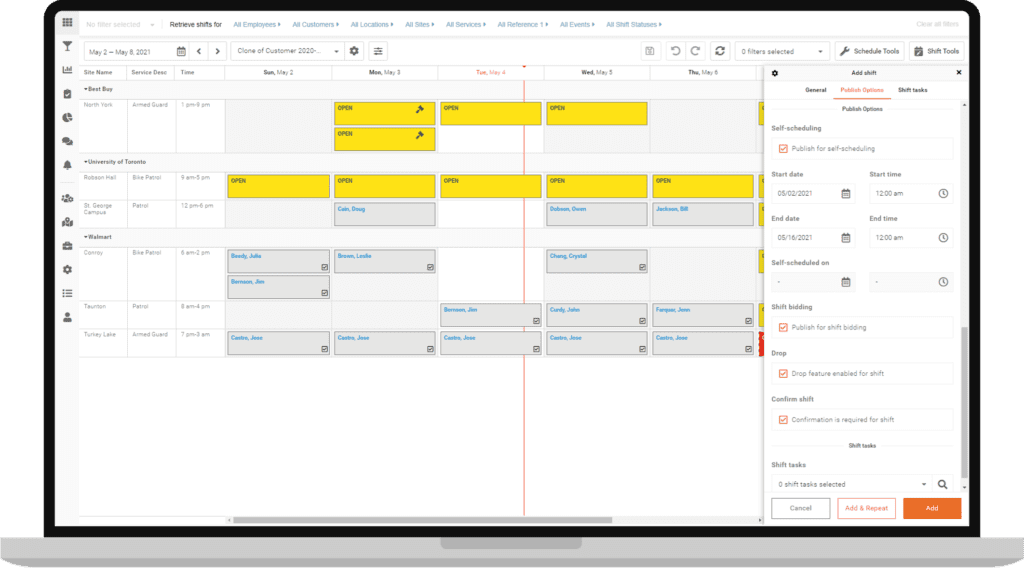As an employer, it is crucial for you to realize that your employees are your single, most important resource. This is true for all businesses and all industries. Employee retention is not something that just happens.
As Richard Branson once said; “Clients do not come first. Employees come first. If you take care of your employees, they will take care of the clients”.
As an employer, you have a responsibility. Foster an environment where your employees feel safe and secure. Work together to create a workplace that they love.
The sooner employers realize the value in this, the better. Ready to learn how to retain your employees?
“Clients do not come first. Employees come first. If you take care of your employees, they will take care of the clients”
RICHARD BRANSON
What is Employee Retention, and why does it Matter?

Employee retention is when employees stay with their current company and do not look for other job opportunities. The opposite of retention is turnover, where employees leave the company for a variety of reasons.
On average, an employee will stay with a company for 4.2 years. If you find that your retention rates are below average, you have some work to do. By 2030, it is forecast that low employee retention will, on average, cost the US $430billion annually.
Benefits of High Employee Retention
There are multiple ways to realize the importance of employee retention. First up, you should take a look at the impact of high employee turnover. You will fall victim to all of those issues if you fail at employee retention, so let’s see why you should invest time and money into it.
Improved Morale
The first, obvious benefit of high employee retention is that morale dramatically improves. We all know that a happy worker is a good worker. Research shows that the happiness of an employee is 23.3% more dependent on their co-workers than on their supervisors.
With good employee retention, co-workers work better together, foster stronger relationships and in turn, morale improves across the board. Employee morale is a huge factor in productivity, and also employee engagement!
Increased Productivity
As we determined when looking at employee turnover, productivity can take a huge hit if retention is low. If you can avoid losing your employees, you save yourself the period of downtime in productivity that comes with searching for, hiring, and training new employees.
In fact, it can take up to 2 years for a new hire to reach the same level of productivity as the employee they replaced. Not only that, but recent studies show that well-engaged employees exhibit a 21% increase in productivity over less engaged employees. By increasing your retention rate, you are helping maintain and improve productivity as team members gain further company knowledge.
Reduced Acquisition and Training Costs

Acquisition and training costs are unavoidable. Even a company with very strong employee retention will eventually have to train existing employees or hire for new roles. Overall, the cost of replacing a trained employee can be more than 200% of their salary. If you can create a strategy that discourages employees to leave, you avoid these costs altogether.
This is a great way to understand just how much time and money you should invest into employee retention strategies. If you’re spending tens of thousands of dollars replacing employees, you can afford to divert some of that spending into creating the right workspace for your employees.
Happier Customers/Clients
As we’ve learned so far, employee retention is directly linked to employee happiness. If your employees are happy, they will pass those feelings on to clients and customers alike. Typically, happier employees provide better service, anticipate problems before they arise, and are invested in the company’s reputation.
As you know, happy customers and clients are the best advertisements for your company. Employees that have been with a company for a long time often forge strong customer relationships, which in turn increases your company’s value in the eyes of the customer.
Ultimately Improve your Bottom Line
Let’s take a second to review all of the benefits of good employee retention for your business;
- Improved morale
- Increased productivity
- Reduced acquisition and training costs
- Happier customers & clients.
When we look at all of these factors together, we can see just how important they are for the profits of your company. All of them directly contribute to your bottom line. Employees that stick around are generally happier, have happier co-workers, are much more productive, and create a more positive experience for your customers. This, along with the cost savings lead to a much healthier bottom-line for your company.
Effective Employee Retention Strategies
So, you finally realize that employee retention is worth the investment. What next? Just like any other business process, developing a comprehensive strategy is the best place to start. There are countless ways to improve retention, but here are the employee retention programs you should definitely consider starting with.
Career Development
Most employees like to think that they have an opportunity for growth within their current organization. If that isn’t an option, you can be sure that they will be looking elsewhere. In fact, more than 70% of high-retention-risk employees say that they will have to leave their organization to advance their careers.

There are many ways to use career development as an employee retention strategy. First off, offer and encourage employees to avail of training and development opportunities. This can be done by offering to subsidize or even cover the costs of educational courses, seminars, and training opportunities.
Remember, investing in your employees’ career path is investing in your business. It also helps to promote internally rather than hiring externally for leadership roles. When employees see co-workers climbing the ladder, it encourages healthy competition and reminds them that those opportunities exist for them. If you do happen to lose an employee, be sure to use exit interviews to understand why they’re leaving and what you can change moving forward.
Benefits & Salary
Not only are benefits a great way of attracting strong talent, but they are a great employee retention strategy. When employees know that their employer cares enough about them to offer extended benefits, they often perform better and stay longer. They are not tempted to look elsewhere for better alternatives, they don’t feel unsupported, and they receive the care they need to perform their job to the best of their ability. This is something you should address during the onboarding process to get off on the best foot possible!
The same can be said for salaries. Of course, a competitive starting salary will get high-value employees in the door. But it won’t keep them there. Offer regular salary reviews to all employees and allow them to justify why they deserve a raise.
When employees are aware that there are opportunities for salary boosts, not only will they stick around, they will work harder to earn those boosts. The increased productivity will cover the costs of the raises, and morale will increase dramatically across the board.
Wellness and Work-life balance

Here at Celayix, we are big fans of work-life balance and consider it a reason we have high employee retention. Employee wellness and employee experience should be at the forefront of all employers’ minds, particularly in today’s business world.
Employees are no longer willing to sacrifice their own mental health and wellbeing for a job. The assumption that employees have to dedicate their lives to their careers to be successful is dated and creates impossible standards. Employees want to feel like they can live satisfying lives outside of the workplace, and you as an employer can support that.
Create a work environment that has a big emphasis on wellness, and you’ll reap the rewards. Company culture is more important than most employees give it credit for.
If your business allows it, consider allowing employees to work from home. Expand on your paid leave policy, and include extra “wellness days” for employees to take time off to look after themselves.
Partner with a local gym to offer discounted membership. Offer extended paternal leave. The list goes on.
There are endless opportunities to improve the wellness and work-life balance of your employees. Even if it means starting small, your employees will appreciate the effort.
Increased autonomy
Building on work-life balance, studies have shown that employees are much more likely to stick around if they are given flexible working options. Building on allowing your employees to work from home, consider flexible working hours, or even flexible scheduling. A recent survey highlighted how valuable flexible working is when 80% of respondents said they’d be more loyal to their employer if they offered flexible work, and 52% said they’d already tried to negotiate flexible work arrangements with their current employer.

Flexible work can be difficult to manage if you don’t have the right resources in place. Employee scheduling software is often the easiest way to introduce and successfully manage flexible working. With Celayix, you can allow employees to self-schedule, shift bid, and declare their availability. Self-scheduling allows you to create all of the open shifts that you need to be filled, and allow employees to claim them on a first come-first served basis.
Shift bidding is when you create the open shifts you need to be filled, and allow employees to “bid” on them by expressing their interest to work them. You can then review all of the bids, and choose the best-fit employee.
Finally, by allowing your employees to input their availability, you are taking their personal schedules into account when scheduling shifts. Employees will appreciate the fact that they are more included in the scheduling process! Show your employees that you care about their work-life balance, and give them the autonomy to work a schedule that works for all parties. This is an easy, and cost effective way to increase job satisfaction.
So, what are you waiting for?
Employee retention is important and should be high on your list of business priorities long term. 87% of HR experts consider retention to be among the highest priorities in the next 5 years. Take action to improve your employee retention today. If you’d like to introduce flexible scheduling to your organization and start increasing employee retention, get in touch with a Celayix Solutions Advisor, and let us help you retain your top talent.





